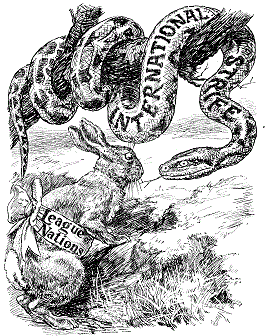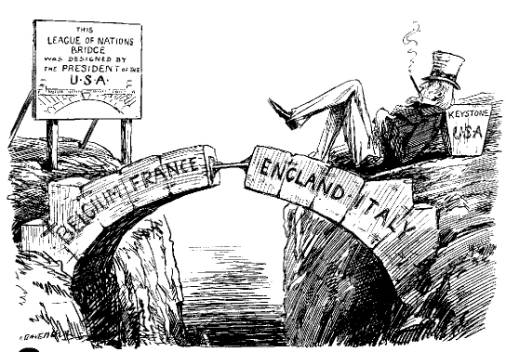|
|
|||||||||||||||||||||||||||||||
|
The League had no means of enforcing its decisions other than the effect of world opinion. S Reed Brett, European History 1900-1960 (1967).
One basic weakness of the League was that it was tied in people's minds to the Versailles settlement, and criticism thrown at Versailles fell on the League. The refusal of the USA to join the League and the fact that Britain and France were the only major nations of Europe who remained full members, severely handicapped its efforts. Written by PJ Larkin, European History for Certificate Classes (1965).
Strengths and WeaknessesThe main strength of the League was that it had been set up by the Treaty of Versailles, and agreed by everybody at the conference. When, later, many people started to criticise and attack the Treaty, this was also a major weakness.
|
Going DeeperThe following links will help you widen your knowledge: In more detail: • The Court of International Justice • The International Labour Organisation • How did the League's membership affect its strength
|
||||||||||||||||||||||||||||||
1. OrganisationOne of the biggest weaknesses was that the Organisation of the League was a muddle.
The main elements of the League's structure were:
|
|||||||||||||||||||||||||||||||
2. How the League kept peaceThe League hoped that it could influence countries to 'do the right thing' by: • Collective Security - the countries of the League agreeing, together, to defend each other • Community of Power - the League acting, togther, to enforce its principles • Moral Persuasion - the 'moral power' of the League lay in the League's Covenant, especially Articles 10-17, in which members promised to keep the peace; the belief that no nation wants the collective international disapproval of other nations. Many writers have pointed out that this is not an effective deterrent against a powerful country which was determined to disobey the League.
If these moral influences failed, the League had THREE POWERS it could use to make countries do as it wanted: 1. Condemnation (the League could tell a country it was doing wrong). 2. Arbitration (the League could offer to decide between two countries). 3. Sanctions (stopping trade). Theoretically, the League was able to use military force, but the League did not have an army of its own – so if a country ignored it, in the end, there was nothing the League could do..
3. MembershipForty-two countries joined the League at the start. In the 1930s about
60 countries were members
Britain and France were the main members, helped by Italy and Japan; they were quite powerful countries (although Britain and France had been weakened by the First World War). A critical weakness was that the most powerful countries in the world were not members. The USA did not want to join (see below) The Russians refused to join – they were Communists and hated Britain and France. Germany was not allowed to join. Without these three big powers, the League was weak.
|
Source AIf any member of the League goes to war, all the other members will behave as if that member country had declared war on them. They will stop trading with that country. They will advise the Council of the League about any armed action that should be taken. adapted from the Covenant of the League of Nations (1919).
Source B ‘Moral Persuasion'– a Punch cartoon of 1920.
Click here for the interpretation |
||||||||||||||||||||||||||||||
America Pulls OutPerhaps the greatest weakness of the League was that, when Wilson got back home to the United States, the American Senate refused to join the League. Americans did not want to get dragged into other countries’ problems. This damaged the League a lot. It did not have access to the prestige, influence, wealth or military power of the United States. It was forced to rely on Britain and France, who had both been weakened by the First World War.
|
Should America join the League? - a brilliant explanation by Ben Walsh of why America refused to join. |
||||||||||||||||||||||||||||||
|
|
◄ Source C‘The Gap in the Bridge’ – a cartoon of 1919 by Leonard Ravenhill in the British magazine
Punch.
Click here for the interpretation
Consider:1. Did the artist of Source B think the League of Nations was powerful? 2. Did the League of Nations have any chance of success?
|
||||||||||||||||||||||||||||||
|
|
|||||||||||||||||||||||||||||||
|
Spotted an error on this page? Broken link? Anything missing? Let me know. |
| ||||||||||||||||||||||||||||||
